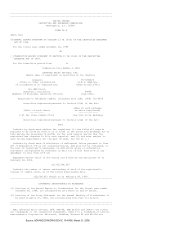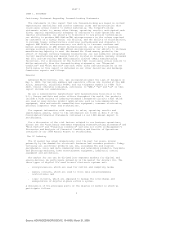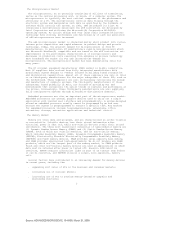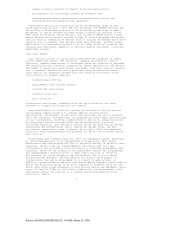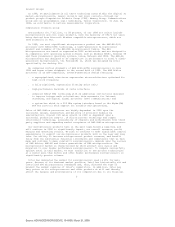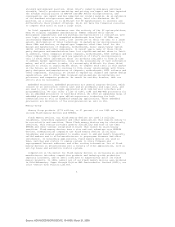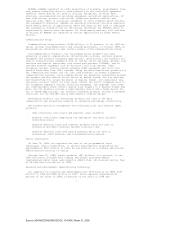AMD 1999 Annual Report Download - page 14
Download and view the complete annual report
Please find page 14 of the 1999 AMD annual report below. You can navigate through the pages in the report by either clicking on the pages listed below, or by using the keyword search tool below to find specific information within the annual report.outstanding with respect to these loans. The planned FASL II costs are
denominated in yen and are, therefore, subject to change due to foreign
exchange rate fluctuations. As of December 26, 1999, the exchange rate was
approximately 103.51 yen to one U.S. dollar (which we used to calculate the
amounts denominated in yen).
In connection with FASL, AMD and Fujitsu have entered into various joint
development, cross-license and investment arrangements. Accordingly, the
companies are providing their product designs and process and manufacturing
technologies to FASL. In addition, both companies are collaborating in
developing manufacturing processes and designing Flash memory devices for
FASL. The right of each company to use the licensed intellectual property of
the other with respect to certain products is limited both in scope and
geographic areas. For instance, AMD and Fujitsu have cross-licensed their
respective intellectual property to produce stand-alone Flash memory devices
with geometrics of 0.5 micron or smaller within the joint venture.
Furthermore, our ability to sell Flash memory products incorporating Fujitsu
intellectual property, whether or not produced by FASL, is also limited in
certain territories, including Japan and Asia (excluding Taiwan). Fujitsu is
likewise limited in its ability to sell Flash memory devices incorporating our
intellectual property, whether or not produced by FASL, in certain territories
including the United States and Taiwan.
Dresden Fab 30. AMD Saxony has constructed and is installing equipment in
Dresden Fab 30, a 900,000-square-foot submicron integrated circuit
manufacturing and design facility located in Dresden, in the State of Saxony,
Germany. AMD, the Federal Republic of Germany, the State of Saxony and a
consortium of banks are supporting the project. We currently estimate
construction and facilitization costs of Dresden Fab 30 to be approximately
$1.9 billion (denominated in deutsche marks) when the facility is fully
equipped. In March 1997, AMD Saxony entered into a loan agreement and other
related agreements (the Dresden Loan Agreements) with a consortium of banks
led by Dresdner Bank AG. The Dresden Loan Agreements provide for the funding
of the construction and facilitization of Dresden Fab 30. The funding consists
of:
. equity, subordinated loans and loan guarantees from AMD;
. loans from a consortium of banks; and
. grants, subsidies and loan guarantees from the Federal Republic of
Germany and the State of Saxony.
The Dresden Loan Agreements, which were amended in February 1998 to reflect
planned upgrades in wafer production technology as well as the decline in the
deutsche mark relative to the U.S. dollar, require that we partially fund
Dresden Fab 30 project costs in the form of subordinated loans to, or equity
investments in, AMD Saxony. In accordance with the terms of the Dresden Loan
Agreements, we have invested $421 million as of December 26, 1999 in the form
of subordinated loans and equity in AMD Saxony (denominated in both deutsche
marks and U.S. dollars).
The Dresden Loan Agreements were amended again in June 1999 to remove a
requirement that we sell at least $200 million of our stock by June 30, 1999
in order to fund a $70 million loan to AMD Saxony. In lieu of the stock
offering, we funded the $70 million loan to AMD Saxony with proceeds from the
sale of Vantis.
In addition to support from AMD, the consortium of banks led by Dresdner
Bank AG has made available $850 million in loans (denominated in deutsche
marks) to AMD Saxony to help fund Dresden Fab 30 project costs. AMD Saxony had
$270 million of such loans outstanding as of December 26, 1999.
Finally, the Federal Republic of Germany and the State of Saxony are
supporting the Dresden Fab 30 project, in accordance with the Dresden Loan
Agreements, in the form of:
. guarantees of 65 percent of AMD Saxony bank debt up to a maximum amount
of $850 million;
. capital investment grants and allowances totaling $287 million; and
. interest subsidies totaling $156 million.
Of these amounts (which are all denominated in deutsche marks), AMD Saxony
has received approximately $275 million in capital investment grants and $23
million in interest subsidies as of December 26, 1999. The
10
Source: ADVANCED MICRO DEVIC, 10-K405, March 21, 2000


